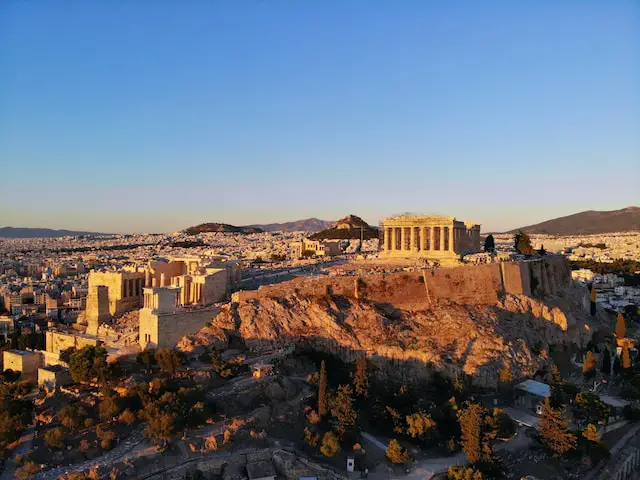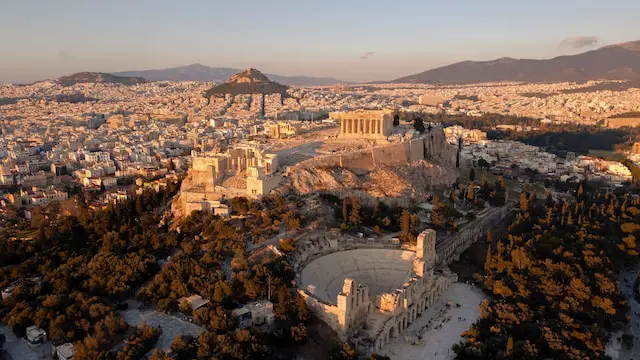The agora was built by various rulers throughout history but reached its peak during the Golden Age of Athens under Pericles’ leadership. The acropolis was primarily constructed as a fortified citadel dedicated to Athena, with its most famous monument being the Parthenon.
TL;DR Agora Vs. Acropolis
The Agora and the Acropolis are two iconic sites in ancient Greece, each holding its own historical and cultural significance. The Agora, which means “gathering place” in Greek, was the bustling marketplace and civic center of ancient Greek city-states. It served as the heart of economic, political, and social activities. the Acropolis, meaning “high city” in Greek, refers to a fortified hilltop or citadel that typically contained temples, monuments, and other sacred structures. The most famous and well-preserved example of an Acropolis is the Acropolis of Athens. It served as the religious and cultural center of the city. The Acropolis also served as a defensive stronghold in times of war.
What is agoras?

Nestled within the heart of ancient Greek cities, the agora was a bustling marketplace and social hub. It served as a central gathering place for merchants, artisans, and citizens from all walks of life. Picture yourself strolling through its vibrant streets – you would encounter rows of shops selling everything from food to clothes, pottery to jewelry.
But the agora was more than just a market; it was also an essential space for civic affairs. In this open-air forum, political debates were held, laws were passed, and justice was administered. Think of it as the birthplace of democracy, where ideas clashed and decisions shaped the future.
Architecturally speaking, agoras typically featured grand colonnades surrounding an open courtyard or square. These impressive structures showcased intricate stone carvings and statues that adorned their facades.
It’s important to note that agoras weren’t confined to Athens alone; they existed in various city-states across ancient Greece. Each had its unique charm and layout but shared a common purpose – fostering community interaction while fueling economic growth.
What is acropolis?

Acropolis, a word that derives from the Greek language, is a term used to describe a fortified hilltop or citadel. It served as the central hub for religious and political activities in ancient Greek cities. The most famous acropolis is located in Athens, known as the Acropolis of Athens.
This iconic site houses several significant structures, such as the Parthenon, Erechtheion, Propylaea, and Temple of Athena Nike. Each building showcases exceptional architectural design and holds great historical importance.
The Acropolis of Athens stands proudly atop a rocky outcrop overlooking the city below. Its strategic location provided both defensive advantages and symbolized its prominence in ancient Greece.
Visitors today can experience firsthand not only the remarkable structures but also gain insights into ancient Greek culture and civilization. Exploring this majestic site offers an opportunity to step back in time and appreciate the impressive achievements of our ancestors.
Agora Vs. Acropolis – Key differences
| Feature | Agora | Acropolis |
|---|---|---|
| Location | Central Athens | Acropolis Hill |
| Purpose | Marketplace, political center, and religious site | Religious and cultural center |
| Construction | 6th century BC | 5th century BC |
| Architectural style | Doric | Doric and Ionic |
| Size | 20 acres | 3 acres |
| Major landmarks | Stoa of Zeus, Hephaisteion, Tower of the Winds | Parthenon, Propylaea, Erechtheion |
| Current use | Archaeological site, open-air museum | Archaeological site, open-air museum |
Who built the agora?
The Agora was not built by a single individual. The term “agora” refers to a central public space or marketplace in ancient Greek city-states. Agoras were typically developed and maintained by the city-state itself as a communal gathering place for various activities, including commerce, politics, socializing, and discussions. Therefore, the construction and maintenance of an agora were collective efforts by the city-state and its inhabitants.
How old is the agora of Athens?
The agora of Athens has a rich history that dates back thousands of years. It is believed to have been established in the 6th century BC, making it over 2,500 years old! This ancient marketplace was not only a hub for commerce but also served as an important gathering place for Athenians.
Over the centuries, the agora underwent various renovations and expansions, reflecting the changing needs and tastes of its inhabitants. The most significant period of construction took place during the Classical era under Pericles’ leadership. During this time, impressive buildings such as stoas (colonnaded walkways), temples, and administrative structures were added to enhance both functionality and aesthetic appeal.
Who destroyed the agora?
During the invasion and occupation by Heruli tribes in 267 AD, the Agora suffered severe damage. The once bustling hub of commerce, politics, and social life was left in ruins. The structures that had stood proudly for years were reduced to rubble.
The subsequent centuries saw sporadic attempts at restoration and rebuilding. However, these efforts were often hindered by political instability and economic challenges faced by Athens.
Later on, during the Byzantine era, another blow would be dealt to this historical site. In 1204 AD, during the Fourth Crusade’s sack of Constantinople (now Istanbul), much of what remained standing in the Agora was looted or destroyed.
Over time, nature also played a role in further deteriorating this iconic site. Neglect coupled with earthquakes resulted in additional damages to an already fragile structure.
Image Credits
Featured Image By – Jim Niakaris on Unsplash
Image 1 By – Dimitris Kiriakakis on Unsplash
Image 2 By – Eduart Bejko from Pixabay








